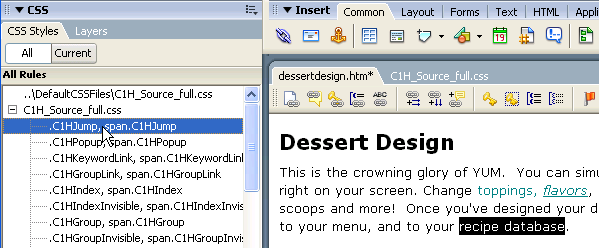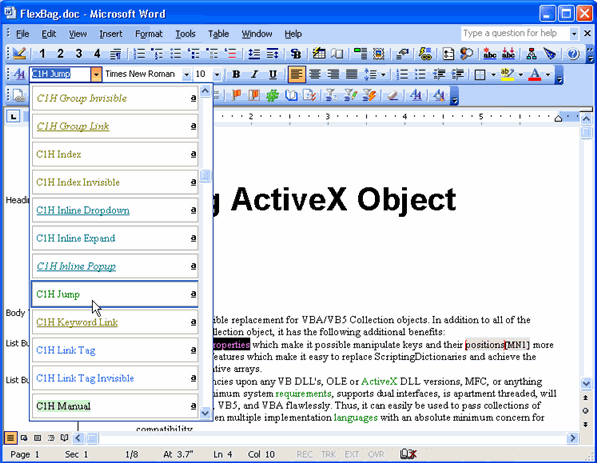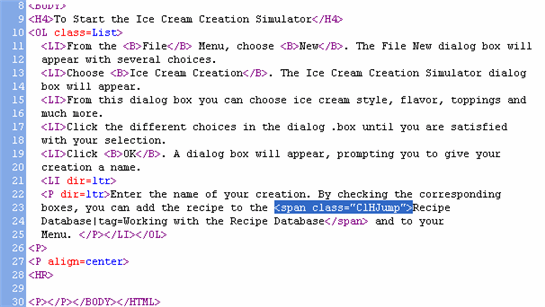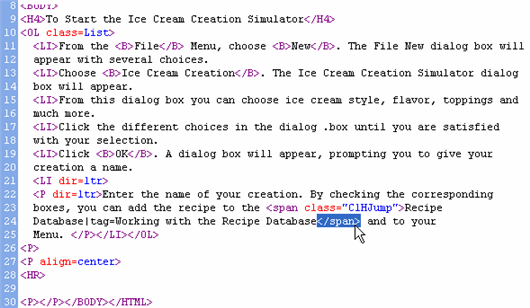There are several ways to create a hot spot, including using the D2HML Styles toolbar in Microsoft Word, FrontPage and Dreamweaver, using the style drop-down box or menu provided with most WYSIWYG HTML editors and Word, or using plain HTML code in an HTML editor. There are no major differences between the methods and how they work with Doc-To-Help; each applies the D2HML style. There are some differences, though, when it comes to convenience.
It is recommended that you use the D2HML Styles toolbar, because it offers the D2HML dialog boxes and creates the D2HML for you. What could be easier!
In Word and most WYSIWYG HTML editors, you can also apply a D2HML style by selecting it from the list of available styles in the style drop-down box or menu. This is not as convenient as using the D2HML Styles toolbar and dialog boxes, but it is an option.
Formatting with plain HTML code is usually done by advanced HTML users, when not using FrontPage, Dreamweaver or another WYSIWYG HTML editor.
Using the D2HML Styles Toolbar in Word:
1. Select the topic or text you want to be part of the hot spot.
2. Click a button from the D2HML Styles toolbar to apply the desired D2HML style.

3. Edit the information in the dialog box, if necessary. In this example, Key Property is assigned to the Tag property of the hot spot. The hot spot text is additional properties|tag=Key Property; it has been formatted with the C1H Jump style. When the hot spot is clicked, it jumps to the Key Property topic. The secondary part, |tag=Key Property, does not appear in the help target when it is built.
Using the D2HML Styles Toolbar in FrontPage and Dreamweaver:
1. Select the topic or text you want to be part of the hot spot.
2. Click a button from the D2HML Styles toolbar to apply the desired D2HML style.

3. Edit the information in the dialog box, if necessary.
In this example, Working with the Recipe Database is assigned to the Tag property. The hot spot text is Recipe Database|Tag=Working with the Recipe Database; it has been formatted with the C1H Jump style. When the hot spot is clicked, it jumps to the Working with the Recipe Database topic. The secondary part, |Tag=Working with the Recipe Database, does not appear in the help target when it is built.
Using the Style Drop-down Box in Word and WYSIWYG HTML Editors
1. Set the properties for your hot spot type, if necessary.
2. Select the topic or text you want to be part of the hot spot, including the secondary part if it exists.
3. Select a D2HML style from the styles drop-down box or relevant menu.

D2HML Styles in Dreamweaver, a WYSIWYG HTML Editor

D2HML Styles in Word
In this example, Working with the Recipe Database is assigned to the Tag property. The hot spot text is Recipe Database|Tag=Working with the Recipe Database; it has been formatted with the C1H Jump style. When the hot spot is clicked, it jumps to the Working with the Recipe Database topic. The secondary part, |Tag=Working with the Recipe Database, does not appear in the help target when it is built.
Using HTML Code in Any HTML Editor:
1. Determine the topic or text that you want to be part of the hot spot, and, if necessary, add a secondary part.
2. Add an opening HTML <SPAN> tag with the appropriate class in front of the hot spot text.

3. Add a closing </SPAN> tag after the hot spot text. Make sure to include the secondary part, if it exists, in the tag.

In this example, the hot spot text is Recipe Database|Tag=Working with the Recipe Database. It has been formatted with the C1H Jump style. When the hot spot is clicked, it jumps to the Working with the Recipe Database topic. The secondary part, |Tag=Working with the Recipe Database, does not appear in the help target when it is built.